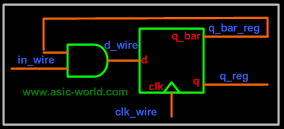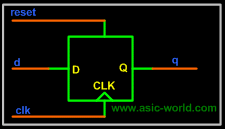有哪位高手知道Verilog HDL中reg与wire类型的变量该怎么使用?
|

- UID
- 165683
- 性别
- 男
|
有哪位高手知道Verilog HDL中reg与wire类型的变量该怎么使用?
有哪位高手知道Verilog HDL中reg与wire类型的变量该怎么使用? 现在小弟刚刚学Verilog HDL语言,这几天被reg搞的头都大了,不知道什么时候该使用,什么时候不该使用?以及在什么情况下使用(例如:在门级,数据流级,行为级)?请您说的详细点吧! 现急需要大哥们的帮助,谢谢! |
|
|
|
|
|
|
 
- UID
- 136199
- 性别
- 男
|

Well I had this doubt when I was learning Verilog: What is the difference between reg and wire? Well I won't tell stories to explain this, rather I will give you some examples to show the difference From the college days we know that wire is something which connects two points, and thus does not have any driving strength. In the figure below, in_wire is a wire which connects the AND gate input to the driving source, clk_wire connects the clock to the flip-flop input, d_wire connects the AND gate output to the flip-flop D input. | | | | 
| | |  | | | | 
| | | There is something else about wire which sometimes confuses. wire data types can be used for connecting the output port to the actual driver. Below is the code which when synthesized gives a AND gate as output, as we know a AND gate can drive a load. | | | | 
| | | 1
module wire_example( a, b, y);
2
input a, b;
3
output y;
4
5
wire a, b, y;
6
7
assign y = a & b;
8
9
endmodule You could download file wire_example.v here
| | | | 
| | | SYNTHESIS OUTPUT | | | | 
| | |  | | | | 
| | | What this implies is that wire is used for designing combinational logic, as we all know that this kind of logic can not store a value. As you can see from the example above, a wire can be assigned a value by an assign statement. Default data type is wire: this means that if you declare a variable without specifying reg or wire, it will be a 1-bit wide wire. | | | | 
| | | Now, coming to reg data type, reg can store value and drive strength. Something that we need to know about reg is that it can be used for modeling both combinational and sequential logic. Reg data type can be driven from initial and always block. | | | | 
| | | Reg data type as Combinational element | | | | 
| | | 1
module reg_combo_example( a, b, y);
2
input a, b;
3
output y;
4
5
reg y;
6
wire a, b;
7
8
always
@ ( a or b)
9
begin
10 y = a & b;
11
end 12
13
endmodule You could download file reg_combo_example.v here
| | | | 
| | | SYNTHESIS OUTPUT | | | | 
| | |  | | | | 
| | | This gives the same output as that of the assign statement, with the only difference that y is declared as reg. There are distinct advantages to have reg modeled as combinational element; reg type is useful when a "case" statement is required (refer to the Verilog section for more on this). | | | | 
| | | To model a sequential element using reg, we need to have edge sensitive variables in the sensitivity list of the always block. | | | | 
| | | Reg data type as Sequential element | | | | 
| | | 1
module reg_seq_example( clk, reset, d, q);
2
input clk, reset, d;
3
output q;
4
5
reg q;
6
wire clk, reset, d;
7
8
always
@ (posedge clk or
posedge reset)
9
if (reset) begin 10 q <= 1'b0;
11
end
else
begin 12 q <= d;
13
end 14
15
endmodule You could download file reg_seq_example.v here
| | | | 
| | | SYNTHESIS OUTPUT | | | | 
| | |  | | | | 
| | | There is a difference in the way we assign to reg when modeling combinational logic: in this logic we use blocking assignments while modeling sequential logic we use nonblocking ones. |
[此贴子已经被作者于2007-7-26 21:33:23编辑过] |
|
这个版主不太冷
===========================
我的中电网博客:http://blog.chinaecnet.com/u/20/index.htm |
|
|
|
|
|
|

- UID
- 166728
- 性别
- 男
|
其实看完这个应该会有点了解了吧 wire 用 assign 赋值 reg 在 always 块时赋值 |
|
|
|
|
|
|

- UID
- 520905
- 性别
- 男
|
| 一个是寄存器型变量,一个是线网型变量,只要您稍微做一个使用点的程序就明白了,单靠别人讲和看书很抽象的. |
|
|
|
|
|
|

- UID
- 779342
- 性别
- 男
|
|
|
|
|
|
|
 
- UID
- 526573
- 性别
- 女
|
|
|
|
|
|